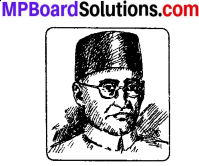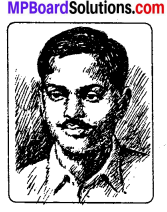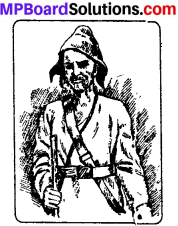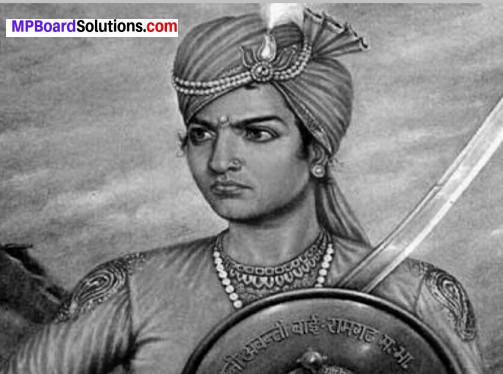In this article, we will share MP Board Class 10th Social Science Book Solutions Chapter 10 Contribution of Madhya Pradesh in Freedom Struggle Pdf, These solutions are solved subject experts from the latest edition books.
MP Board Class 10th Social Science Solutions Chapter 10 Contribution of Madhya Pradesh in Freedom Struggle
MP Board Class 10th Social Science Text Book Exercise
Objective Type Questions
Mp Board Class 10th Social Science Chapter 10 Question 1.
Multiple Choice Questions:
(Choose the correct answer from the following)
Students can also download MP Board 10th Model Papers to help you to revise the complete Syllabus and score more marks in your examinations.
Contribution Of Madhya Pradesh In Freedom Movement MP Board Class 10 Question (a)
Which freedom fighter of Madhya Pradesh had the honour of becoming President of India:
(a) Dr. Shankar Dayal Sharma
(b) Pt. Sunderlal
(c) Pt. Dwarika Prasad Mishra
(d) Pt. Shambhunath Shukla.
Answer:
(a) Dr. Shankar Dayal Sharma
Contribution Of Mp In Freedom Movement MP Board Class 10 Question (b)
After which freedom fighter’s name, Bhopal University has been named:
(a) Seth Govinddas
(b) Barkatullah
(c) Harisingh Gaud
(d) Rani Durgavati.
Answer:
(b) Barkatullah
Class 10th Social Science Chapter 10 MP Board Question (c)
From which city of Madhya Pradesh the ‘Jhanda Satyagraha’ begin: (MP Board 2010)
(a) Indore
(b) Sagar
(c) Jabalpur
(d) Bhopal.
Answer:
(c) Jabalpur
Class 10 Social Science Chapter 10 MP Board Question 2.
Fill in the blanks:
- ……………………. (name) lived in village Dhimarpura by the name Harishankar Bhramachari.
- Rani Avantibai was queen of Ramgarh of ………………….. district.
- Rani Laxmibai captured Gwalior with the help of ……………………. (name).
Answer:
- Chandrashekhar Azad
- Manda
- Tatya Tope
Contribution Of Madhya Pradesh In Freedom Struggle MP Board Class 10 Question 3.
Match the column:

Answer:
- (iv)
- (i)
- (ii)
- (iii)
MP Board Class 10th Social Science Very Short Answer Type Questions
Class 10 Social Science Mp Board Question 1.
Where was Chandrashekhar Azad born?
Answer:
Village Bhabhra of Jhabua District.
Contribution Of Mp In Freedom Struggle MP Board Class 10 Question 2.
Name the places of organisations set up in Madhya Pradesh?
Answer:
‘Gurukul’ 1929 (Satna), Hindustani Seva Dal 1931, Charkha Sangh (Rewa), Gwalior Rajya Seva Sangh and Harijan Sevak Sangh 1935 (Gwalior), Lok Sevak Sangh 1939, (Khargone), Gram Seva Kutir 1935 (Sendhwa), Seva Samiti (Betul). Seva Samiti (Betul), Seva Mandal (Ratlam) Jnyan Prakash Mandal (Indore) etc.
Mp Board Solution Class 10 Social Science Question 3.
Which freedom fighter’s name (soldier) of Indian National Army was associated with Shivpur?
Answer:
Colonel Gurbax Singh Dhillon.
MP Board Class 10th Social Science Short Answer Type Questions
Question 1.
Name the newspapers published from Madhya Pradesh to arouse awemess for national awakening? (MP Board 2012)
Answer:
During that period many newspaper like Karmaveer, Ankush, Subodh Sindhu, Nyaya Sudha, Arya Vaibhav, Lokmat, Praja Mandat Patrika, Sarswati Vilas, Saptahik Awaz and Subaha Watan were published, which raised voice against the oppressive and unjust policies of the British. This helped in arousing nationalist feelings.
Question 2.
In what way the people of Madhya Pradesh made their contribution in the Civil Disobedience Movement?
Answer:
The people of Madhya Pradesh made their contribution in the Civil Disobedience Movement in several ways. Some of the main movements are as:
- The forest struggle (satyagraha) of Turia Jungle.
- Jungle Satyagraha of Ghodadongri.
- The Firing Incidence of Charanpaduka.
During the freedom movement many political and social service institutions were set up; their ways of working and policies, though different, their contribution in the movement was remarkable. Thus contribution of the people of Madhya Pradesh was memorable.
Question 3.
What was Jungle Satyagraha? (MP Board 2013)
Answer:
When in 1930 Gandhiji marched to Dandi and led the ‘Namak Satyagraha’, at the time the Congress workers of Seoni, under the leadership of Durga Shankar Mehta carried out the ‘Jungle Satyagraha’. About 9 – 10 kms from Seoni, a movement to cut grass from the Government Sandalwood Gardens, was started.
In continuation of the above movement another movement to cut grass in the jungles of Turia 28 kms from Seoni. It was planned to enter Turia jungle on 9th October, 1930. The police and range officers insulted the freedom fighters and the public who had assembled there in support of the freedom fighters.
The Deputy Commissioner, Seoni ordered police to open fire on them to ‘teach a lesson’. On the spot four tribals viz. Guddobai, Ramabai, Bemabai and Birju Gond died. This incidence is a proof of the fact that the freedom movement spread even among the tribals. The bodies of these martyrs were not handed over to their families.
Question 4.
How did ‘Jhanda Satyagraha’ take place? Explain?
Answer:
During the freedom movement, tricolour with spinning wheal (charkha) in the centre was having the status of national flag. During 1923 an incident with regard to its honour occurred that the whole nation stood for it and even the British administration had to recognize that fact.
This incidence has gone in the history of freedom struggle and is known as ’Jhanda Satyagraha’. The Congress party constituted a committee under the leadership of Hakim Ajmal Khan to assess the extent of mental preparedness of the people in favour of the Non – Cooperation Movement.
The Jabalpur Congress Committee decided to honour Mr. Khan and hoist the tricolour on the building of Jabalpur Municipality. The British Government took this act of honouring Mr. Khan as an insult of the British rule and ordered the police to not only remove the flag but insult is by crushing it under feet. Consequently the people were extremely annoyed. They agitated and this agitation became a national agitation only after few months.
MP Board Class 10th Social Science Long Answer Type Questions
Question 1.
Describe the contribution of freedom fighters of Madhya Pradesh in the freedom struggle of 1857?
Answer:
From every part of Madhya Pradesh fighters took part in the freedom struggle. There was hardly any area where freedom fighters were not there. Everyone from almost all the areas of Madhya Pradesh took part in the struggle. Only because of these people that we are breathing in free atmosphere. Although freedom fighters did not confine themselves to a specific area; they considered the nation above everything.
Central character of struggle for freedom of 1857 was Rani Laxmi Bai, who belonged to Jhansi, fought her important battle in Madhya Pradesh posed challenge to British and won the war. She caputred the Gwalior fort with the help of Tatya Tope. When English capton Hughes approached Gwalior fort, she fought bravely and on 18th June, 1858 near Gwalior she sacrificed her life in the Baba Gangadas Bag.
Tatya Tope, the great, fighter of first freedom struggle helped Rani Laxmi Bai to capture Gwalior. Even after the death of Rani Laxmi Bai, Tatya Tope continued guerilla fighting with the British for two years in Madhya Pradesh and other parts of India. A friend betrayed Tatya Tope and he was imprisoned and later hanged in Shivpuri. Some other main freedom fighters were Virangana Rani Avantibai, Raja Bakhtawar Singh, Raja Shankar Singh and Raghunath Shah, Thakur Ranmat Singh, etc.
Question 2.
What impact ‘Civil Disobedience Movement’ and ‘Quit India Movement’ had on Madhya Pradesh?
Answer:
The trible district Betul was also a centre of freedom struggle and the tribals here also participated in the freedom movement. After the ‘Jungle Movement’ of 1930 the tribal freedom fighters also took the reigns of the freedom movement in their hands under the leadership of Ganjan Singh Korku of Banjari Dhal.
When the police reached Banjari Dhal to arrest Shri Ganjan Singh the local tribals strongly opposed. The police opened fire and in the firing Koma Gond died and became a martyr. Ganjan Singh however escaped. In a place named Jambada a crowd gathered to free the arrested tribals, police opened fire on the crowd, Ramu and Makdu Gond died and became martyrs.
In August 1942 a new chapter in the freedom struggle of India was added, popularly known as ‘Quit India Movement’. The All India Congress Committee passed are solution, in the meeting of Indian Congress Committee held on 8th August, 1942 in Bombay. On the 9th August many big leaders including Mahatma Gandhi were arrested.
In this situation, many big leaders of Madhya Pradesh like Pt. Ravi Shankar Shukla, Dwarka Prasad Mishra returned to Madhya Pradesh to fight against such oppressive activities of the British Rule. People organised themselves in every village, tehsil and town, thus a beginning of the struggle was made. In Betul the struggle assumed serious form and the police opened fire.
In places like Mandla, Sagar, Hosharigabad, Chhindwara Jabalpur etc. people attacked Government offices and burnt Government records, railway, postal and transport services were disrupted. The police took recourse to oppression were disrupted. Seth Govindas was arrested in Jabalpur. As a consequence of this the struggle gathered momentum. The people participated in the struggle with great enthusiasm in places like Khandwa, Khargone, Narsinghpur, Damoh, Balaghat etc.
Question 3.
Write notes on:
- Barkatullah Bhopali
- Chandrashekhar Azad
- Tantya Bhil
- Kunwar Chain Singh
- Virangana Avantibai
- Thakur Ranmat Singh.
1. Barkatullah Bhopali:
Mohammad Barkatullah continuously made efforts of Independence of India, while living in foreign countries. He was made the Prime Minister of the interim Government of India set up in Kabul. Political activities started in Bhopal from the year 1934.
In this very year publication of two weekly papers were started viz. ‘Subahe Watan’ in Urdu by Shakir Ali Khan and ‘Praja Pukar’ by the Hindu Mahasabha of Bhopal State. In 1938 the Hindu and Muslim population together, set up ‘Praja Mandal’.

2. The Great Martyr Chandrashekhar Azad:
He was born in village Bhabhra of Jhabua district (Madhya Pradesh). He joined the Non-cooperation Movement in the early age of 14 years. When he was arrested he told in the court of law, ‘Azad’ as his name, ‘Independence’ as father’s name and ‘Prison’ as his address. Since then suffix ‘Azad’ added to his name.
For the Britishers, Azad’s name was the synonym for terror. The credit or arousing a sense of patriotism and prepare people foi armed revolution and preparing a generation of revolutionaries goes to Azad. Between the year 1926 to 1931, Azad was associated in almost all the revolutionary activities and associated himself in about 100 incidences of fight against the Britishers and became General Officer in Command of the Indian Socialist Republican Party.
He set up his headquarters in a village named Dhimarpura on the Bank of the river Satar in Jhansi. During day hours he used to narrate the story of Lord Ram, arrange for meals for the people and from there used to direct revolutionary activities in Jhansi.
He somehow reached Allahabad, hiding himself from the police and on 27 February, 1931, he was sitting in the Alfred Park. The police rounded him there at 10 a.m. in the morning. Firing started from both the sides, when only one bullet was left in his pistol he shot himself by firing a bullet neaiythe ear.

3. Tantya Bhil:
After the freedom struggle of 1857 Tantya Bhil became a symbol of terror for the Britishers. Dopia and Bijamija, his associates were also his partners in the Revolutionary activities. For years they were living amongst the local people and at the same time conducted revolutionary activities as a result of which they became a big challenge for the Britishers. Tantya Bhil was arrested under a conspiracy and was hanged in the year 1886. Tantya is a hero even today among Bhils.

4. Kunwar Chain Singh:
Prince Chain Singh of Narsinghgarh was insulted by political Agent Maddoc of Sehore Cantonment. Hence Chain Singh started agitation against the British. In 1824 there was a fierce battle between Chain Singh and the British on a sport which is presently known as Tehsil Chouraha. Chain Singh and handful of brave soldiers sacrificed their lives while fighting with British soldiers in Sehore’s Dussehra Bagh.
5. Virangana Rani Avantibai:
The queen of Ramgarh of Mandla district also showed extra ordinary love for her motherland and fought bravely. Ramgarh is a small town in Mandla district. In 1850 after the death of Raja Lakshman Singh his only son Vikramjeet Singh was declaired mentally sick and unfit to rule.
British Government took the regions of administration in their hands and appointed their officer. The royal family was sanctioned annual subsistence allowance. Rani Avantibai (Wife of Raja Laxman Singh) of Ramgarh was very able and intelligent lady who wanted to rule the state in her son’s name but at the time the ’policy of annexation’ (Hadap Neeti) was being strictly implemented.
Rani Avantibai opposed this, fought with the officer who was appointed by the Britisher there and took the reigns of administration in her hands. She contacted the thakurs and malguzars of the district and sought their cooperation. Many Zamindars promised to lend their support.
The Rani used to lead her soldiers in battlefield in soldier’s uniform. In April 1858, the Britishers attacked Ramgarh, the Rani assessed her strength and vacated the fort and went into the adjoining forests. From there she constantly attacked the Britishers but one of these attacks proved to fatal.
When she saw that she is surrounded and will be surely caught, this brave lady instead of courting arrest, got down from the horse, seized sword from her body – guard and pierced it in-her chest and laid her life bravely for her motherland.

6. Thakur Ranmat Singh:
Thakur Ranmat Singh of village Manakhari of Satna district also gave tough fight to the Britishers in the struggle of 1857. The Thakur was unhappy with the activities of the political Agent Maddoc and decided to fight with Britishers. He along with his companions organised an army in the jungles of Chitrakoot and attacked the Residency in Nagod. The resident fleed.
Thakur Ranmat Singh attacked the Naogaon cantonment also, after a few days and a British platoon of Barodha was killed. A prize of Rs. 2000 was declared on the Thakur. After fighting with the Britishers for a long times, he was arrested by the Britishers on day when he was resting in his friend’s house, he was caught unaware and was hanged in the year 1859.
MP Board Class 10th Social Science Additional Important Questions
Objective Type Questions
Question 1.
Multiple Choice Questions:
(Choose the correct answer from the following)
Question (a)
Bundela revolt was started in the period of:
(a) 1740 – 1742
(b) 1840 – 1842
(c) 1892 – 1897
(d) 1940 – 1942.
Answer:
(b) 1840 – 1842
Question (b)
Jhanda Satyagraha was started in the year of:
(a) 1920
(b) 1921
(c) 1922
(d) 1923.
Answer:
(d) 1923.
Question (c)
Chandrashekhar Azad was bom at:
(a) District Jhabua
(b) District Mandsour
(c) District Harda
(d) District Bhopal (MP Board 2009)
Answer:
(a) District Jhabua
Question (d)
Who fought with British by Guerilla system?
(a) Raja Laxman Singh
(b) Bakntawar Singh
(c) Tatya Tope
(d) Ganjan Sing Korku
Answer:
(c) Tatya Tope
Question 2.
Fill in the blanks:
- Namak Satyagrah was started by …………………….
- Jungle Satyagrah was the satyagrah of …………………….
Answer:
- Mahatma Gandhi
- Triblals.
Question 3.
True and False type questions.
- Chandrashekhar Azad was bom in Sagar district.
- In Madhya Pradesh, Quit India Movement was started under the leadership of Mahatma Gandhi.
Answer:
- False
- False.
Question 4.
Match the Column:

Answer:
- (d)
- (a)
- (b)
- (c)
Answer in One – Two Words or One Sentence
Question 1.
What is known as Jalianwala Bagh of M.P.? (MP Board 2009)
Answer:
The firing incidence of Charanpaduka on 14th January 1931.
Question 2.
Who were killed in firing of Madhya Pradesh’s Jalianwala Bagh?
Answer:
Seth Sunderlal, Dharamdas Khirwa, Chirku, Halke Kurmi, Ramlal Kurmi and Raghuraj Singh.
Question 3.
Write the name of queen of Ramagarh of Mandla District? (MP Board 2009)
Answer:
Gondwana queen, Rani Durgavati shah Maravi ruled Mandla province and fought against Akbar in her valiant effort to save her.
Question 4.
What slogan was given by Gandhiji on 8th August 1942?
Answer:
Do or Die.
Question 5.
When was a meeting organised at Talak Bhoomi Talaliya in Jabalpur?
Answer:
On 9th August 1942.
Question 6.
Write the name of main revolutionaries of Jaipur?
Answer:
Raja Shankar Singh and Raghunath Shah.
Question 7.
Name the main centre of revolt?
Answer:
The main centre of revolt were Gwalior, Bhopal and Indore.
MP Board Class 10th Social Science Very Short Answer Type Questions
Question 1.
What do you mean by Bundela revolt?
Answer:
Bundela, Rajput, Gond and Lodhi rulers and landlords revolted against the British and fought against the British rule in Narmada Sagar region of Buridelkhand.
Question 2.
Why did Prince Chain Singh started revolt against the Britishers?
Answer:
Prince Chain Singh of Narsinghgarh was insulted by political Agent Maddoc of Sehore Cantonment. Hence Chain Singh started agitation against the British. In 1824 there was a fierce battle between Chain Singh and the British on a sport which is presently known as Tehsil Chouraha.
Question 3.
Who was the hero of 1857 from Indore?
Answer:
In the freedom struggle of 1857 Sadat Khan and Bhagirath Silawat of Indore played an important role. They gave tough fight to the Britishers but were caught and hanged in Indore. Their sacrifice is also worth mentioning.
Question 4.
Who did plan to loot of Punjab Mail?
Answer:
Three freedom fighters Veer Yashwant Singh, Devnarayan Tiwari and Dalpatrao prepared a plan to loot the rifles and other belonging of the officers who travelled by Pubjab Mail.
MP Board Class 10th Social Science Short Answer Type Questions
Question 1.
What do you mean by Bundela Movement?
Answer:
In the land of Madhya Pradesh second flame of revolt flickered in 1840-1842 when in Narmada Sagar region of Bundelkhand. Bundela, Rajput, Gond and Lodhi rulers and landlords revolted against the British and fought against the British rule. Dhillan Shah of Madanpur, Hirde Shah of Heerapur, Raja Parinit of Jaitpur, Rao Basant Singh of Chirgaon and Deewan Bundela of Jheejhaon were heroes of this agitation, but because of lack of unity and power of British army the revolt could not succeed.
Question 2.
What were the main centres of 1857 in Madhya Pradesh?
Answer:
There was mass intolerance in public and in 1857 the feeling became widespread. Like other parts of India there were many small Riyasats in Madhya Pradesh of the rulers and Nababs were faithful to British but the soldiers of their army after hearing the news of revolt, were eager to help their fellow soldiers.
Main centre of revolt were Gwalior, Bhopal and Indore. The places where the flame of revolt flared were Sagar, Jabalpur, Narsinghpur, Hoshangabad, Nangaon, Gwalior, Jhansi, Shivpuri, Bhopal, Neemuch, Indore, Mahidpur, Mandsaur etc.
Question 3.
When did the Gwalior – Goa conspiracy take place?
Answer:
Gwalior was the seat of the revolutionaries. Gendalal and Chandrashekhar Azad were hiding in various parts of Gwalior. In 1930 an organisation was set up in Gwalior for boycott of foreign textiles. The Gwalior – Goa conspiracy took place in 1932. Under this movement arms were brought from foreign countries and were being made available to the revolutionaries. Those who were punished in this regard were Balkrishna Sharma, Girdharilal the main.
MP Board Class 10th Social Science Long Answer Type Questions
Question 1.
Describe the contribution of Madhya Pradesh in the national movement?
Answer:
All sections of the population of Madhya Pradesh actively participated in the national movement. The tribals played their role, the ruling families and their subjects also participated in the struggle. The peasants also made their contribution in their own way. Thus people of all sections participated in the ‘Non – cooperation movement’, ‘Civil Disobedience’, Salt Movement’, ‘Jungle Satyagrah’ and the movement of 1942.
The centre of activities of the great revolutionary, Chandrashekhar Azad was Orcha. The Red Army of Maganlal Bagdi took lead as an armed revolutionary. The people of Madhya Pradesh participated in the non cooperation movement and took part in the activities like movement against in the activities like movement against consumption of liquor, Tilak Swaraj fund, boycott of foreign cloth, boycott of Government schools and establishment of national educational institutions, handloom industry etc.
The advocates abandoned their practice. Those advocates who went to courts wore Gandhi caps. District committees ignored Government orders and hoisted national flag. The police arrested all the leaders. Pandit Sunderlal was tried in the court of law and imprisoned for six months. All the members of Jabalpur Municipality the leaders Second batch comprising Premchandra, Sitaram Jadhav, Chhigelal Swarnkar and Todermal hoisted flag on the town hall. The ‘Jhanda Movement’ spread in other parts of India including Nagpur.
Question 2.
Discuss the role of Bhils in 1857?
Answer:
The Bhils of Malwa and Nimad area were freedom lovers. To supress them the Britishers had formed an army called the Malwa Bhil Cops. Khajya and Bhima were working in the army in the capacity of ’Nayak1. Against the oppressive policy of the Britishers these two soldiers increased their activities of opposition (associating with the 1857 Freedom Struggle).
Worried by their activities the Britishers launched a campaign to arrest them, Khajya was killed in 1860 (by deception) while Bhima continued his struggle. He was also arrested in 1867. Besides these, the role of Rao Khalak Singh Daua of Sevdha (Datia), Daulat Singh of Raghogarh (Dewas) Waris Mohammad Khan of Bhopal, Nawab Adil Mohammad Khan of Ambapani (Bhopal) and Phajil Mohammad Khan Sohagpur (Shahdol), Garrul Singh etc. was also important in the freedom struggle of 1857.